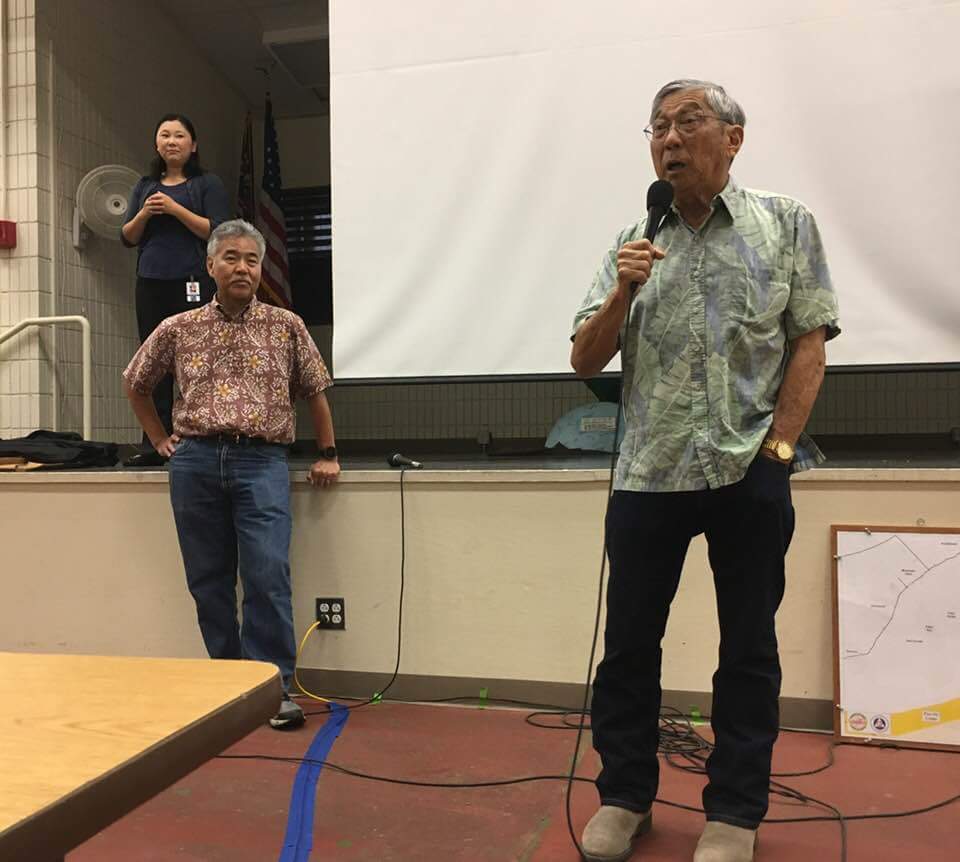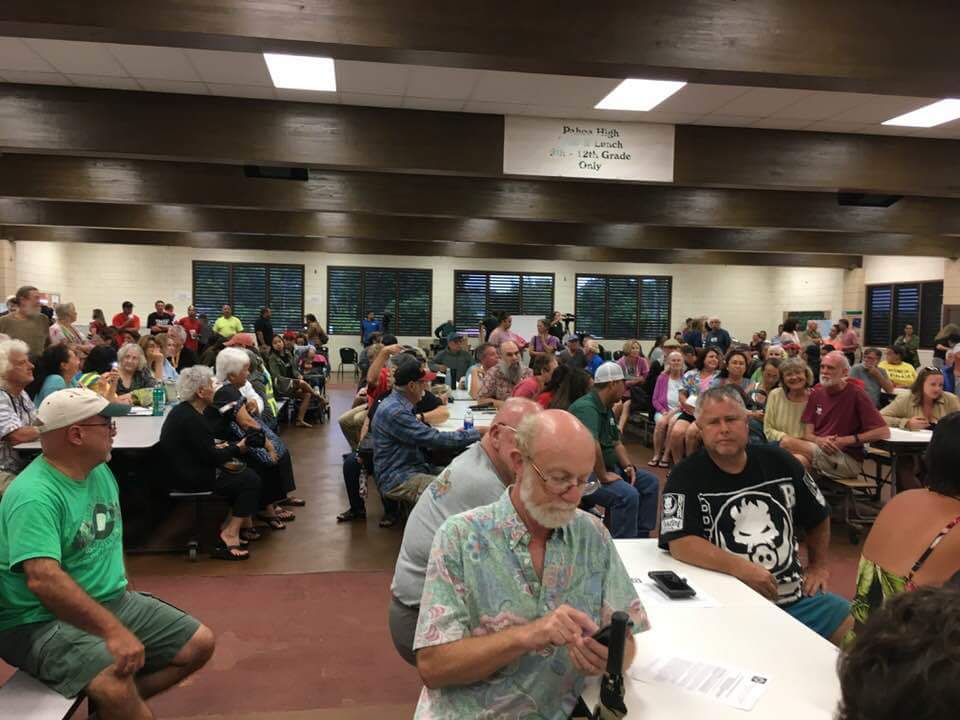Puna Residents Express Concerns at Pāhoa Meeting

Hawai‘i Island Mayor Harry Kim and Hawai‘i Gov. David Ige at the second Puna Community Meeting on the Leilani Estates Eruption on May 7, 2018, at Pāhoa High School Cafeteria on Hawaii Island. PC: Ariel Murphy.
Emergency officials held a second Puna community meeting at the Pāhoa High School Cafeteria.
On Monday, May 7, 2018, officials provided updated information on the Leilani Estates eruption, answered questions and addressed concerns for between 500 to 600 attendees.
Officials from the following agencies were in attendance: Hawai‘i County Mayor’s Office, Hawai‘i
County Civil Defense, Gov. David Ige, United States Geological Survey (USGS), Department of Health, Hawai‘i Police Department, state Department of Education, Hawai‘i Fire Department, Department of Water Supply, the Prosecuting Attorney’s Office, Hawai‘i Volcanoes Observatories (HVO) and the districts’ State Representatives and Senator.
Hawai‘i County Mayor Harry Kim acknowledged that some of his policies “irritated” residents, but he
assured the crowd that, “Every decision was made for what we thought was best for your safety.”
Mayor Kim said he was committed to try harder to keep residents better informed.

Hundreds gather for the second Puna Community Meeting on the Leilani Estates Eruption, which was held May 7,
2018, at Pāhoa High School in the gymnasium. PC: Ariel Murphy.
The mayor also said that according to FEMA, the eruption does not meet the requirements for federal
assistance at the present time, but said that Gov. David Ige had contacted the Federal Emergency Management Agency (FEMA) to get the process started.
Gov. Ige addressed residents at the meeting after he viewed the impacted area and met with residents and volunteers at community information centers.
“I am here tonight to be available and to listen, said Gov. Ige.
He advised everyone to ask their insurers if they have fire coverage—not lava coverage.
“If you have fire coverage, we believe there should be some reimbursements,” he added.

National Guardsmen at Kona Airport, May 6, 2018. However, it was not determined whether these particular Nation Guard members were being deployed to Leilani Estates. PC: Susan Miller
According Gov. Ige, 75 National Guard members have been deployed to the area.
Gov. Ige contacted both FEMA and the White House about the events taking place and expressed that Puna
was going to need assistance.
Ige said he was there to “understand more of your concerns and issues.”
Air Quality
Dr. Al Bronstein from the state Department of Health addressed concerns over the elevated levels of sulphur dioxide in the air.
“Sulfur dioxide (SO2) is a gas—you cannot see it, said Dr. Bronstein, “It somewhat smells like a match stick.”
He explained that SO2 likes to stick to something, for example to the mouth, nose and respiratory
systems. Reactions to SO2 include irritation, coughing and tearing up. Bronstein explained that when SO2 hits the lining of the respiratory system, it makes acid, causing tissue swelling, which then results in coughing, chest tightening and inability to catch one’s breath. Bronstein said people can succumb to the effects of sulfur dioxide from the swelling.
Those with asthma, bronchitis, emphysema and heart disease are among those at greatest risk, as well as the elderly, children and those who are pregnant.
“Children are at higher risk because they breathe faster than adults, taking in more SO2,” the doctor said.
He warned that exposure to sulfur dioxide can make people extremely ill.
“With these gases we want to limit our exposure,” the doctor said.
Civil Defense Administrator Talmadge Magno added that residents could “shelter in place” by closing window, running air conditioners on circulated air, and closing houses before the SO2 comes around.
The Hawai‘i Fire Department reports extremely dangerous air quality conditions due to high levels of sulfur dioxide gas in the evacuation area.
The high levels detected are an immediate threat to life for all who become exposed. First responders
may not be able to come to the aid of residents who refuse to evacuate.
Check the air quality in your area here.
Water
Residents expressed concerns and asked questions about the safety of their catchment water and acid rain.
Dr. Bronstein said there has not been a real problem with rain water, emphasizing his previous message—the issue has been inhalation of SO2.
Someone in the crowd asked further about the catchments and Magno told residents they can add
baking soda to their water tanks.
Click here for more information.
The Department of Water Supply informed residents that water lines to the Lanipuna and Green Lake tanks have been restored and the tanks are slowly refilling.
Earlier in the week, lava cut the water line, causing the tanks to empty. The bypass line was just completed and water restored.
Residents are advised to continue to restrict water usage to only health and safety purposes while the tanks refill.
Water spigots are located in Vacationland, Lava Tree State Monument and Nanawale.
Puna Geothermal Venture (PGV)
As lava moves through the Leilani Subdivision and closer to PGV, a geothermal energy conversion plant that sells electricity to the Hawaii Electric Light Company (HELCO), community leaders and residents have been raising concerns over the chemicals stored at the facility and the possibility of an explosion should this eruption reach the 60,000 gallons of pentane onsite. Pentane is a highly flammable liquid.
At the meeting, PGV representative Mike Kaleikini told attendees that the site is still closed and that all the geothermal wells are shut.
“As we speak, we are making arrangements to transport our pentane to a remote location to be taken
off site,” Kaleikini said.
He added that 12,000 gallons will be moved this week and as they receive more containers, the remaining 48,000 gallons will be moved.
A resident in the audience asked if PGV was going to plug the geothermal wells.
Kaleikini said, “No. We just had a 6.9 [magnitude earthquake] and the wells are all in good shape.”
Many in the crowd attempted to voice concerns and ask further questions—but the meeting moved on to the next speaker.
“In the open forum, there were a lot of people who wanted the PGV representative in front of the assembly to answer questions so that everyone can hear the answers. That didn’t happen,” said Puna
resident and community volunteer Ariel Murphy. “I went to the PGV representative and advised him to
issue press releases so that the public who are hungry for info about the potentially dangerous and
toxic gas stored in the premises of PGV are assured that there is no danger of explosion.”
Big Island Now will bring up dates as this story develops.
HELCO
HELCO President Jay Ignacio explained, “With PGV power plant shut off, we still have sufficient
generation to serve the entire island.”
Currently, half of Leilani Estates is without power. Ignacio said at this time rebuilding is not an option as lava activity is too unstable.
He also stressed the importance of staying away from downed power lines. The lines should be “off,” but according to Ignacio, those within the evacuated zones should not trust that the downed wire is not energized and should stay clear.
Downed power lines have been seen in Leilani Estates.
“We are really concerned about safety,” stated Ignacio.
United States Geological Survey
The main message from USGS is that more activity is expected.
Public Schools
Attempting to bring some normalcy for the keiki in this area the state Department of Education announced that all public schools in Puna are currently open.
During the meeting, Hawaii District Ka‘u-Kea‘au-Pāhoa Superintendent Chad Keone Farias said that public schools will “remain open until someone says we have to close. Unless you hear otherwise, we will be here for your kids every single day.”
Evacuee Information
Evacuees were offered to sign up for support services and to get placards for their vehicles for easier
and quicker access to the evacuated subdivisions.
Residents were first let back in to collect belongings, animals and to check their homes on Sunday, May 6, 2018, after many were kept out after the lava eruption surfaced in the afternoon on Thursday, May 3, 2018.
Many were forced to leave behind pets and fled with only the clothing on their backs.
Emergency officials will allow residents to enter Leilani Estates between 7 a.m. and 6 p.m. if conditions remain safe to do so.
The conditions in Lanipuna Gardens Subdivision have not allowed officials to permit access. The level of sulphur dioxide has been too high for safe entry, and two more fissures opened up in the area at about 2 p.m. today, May 8.
Support Services
There are two community information centers in Pāhoa—Sacred Heart Church and Pu‘u Honua O Puna across from Pāhoa High School.
The County of Hawai‘i opened an Eruption Information Center on May 7 in Pāhoa at Sacred Heart. The center is open Monday to Friday, 8 a.m. to 3 p.m. In addition to information about the eruption, the center will offer social service information for the evacuees. The following agencies will be onsite: County of Hawai‘i – Office of Aging, Neighborhood Place of Puna, Child and Family Services, The Food Basket, Bodacious Women, Catholic Charities, HOPE Services Hawaii, Big Island Substance Abuse Council and County of Hawaii – OHCD Existing Housing Division.
The Pāhoa Community Center is a pet friendly shelter, and the Kea‘au Community Center has been established as an alternative pet-friendly evacuation center farther away for those sensitive to
vog.
Call Civil Defense at (808) 935-0031 for any emergency needs.
There is no date set for the next Puna community meeting. Big Island Now will bring you that information as soon as it is provided, and Na Leo Tv will broadcast the meeting live on Channel 54 and 55.
Magno ended the meeting asking everyone to be safe and mindful. “Let us know how we can do our jobs better and we will listen to you.”
Sign up for Civil Defense messages online.
For texts and emails from the USGS sign up online.
A temporary, live, USGS web cam is positioned near Kapoho, pointing northwest over Leilani Estates.
Sponsored Content
Comments








